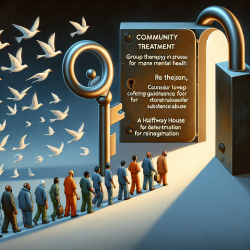Understanding the Impact of Prison Deinstitutionalization on Community Treatment Services
The concept of prison deinstitutionalization has gained traction in recent years, highlighting the need for effective community treatment services. A recent study, "The impact of prison deinstitutionalization on community treatment services," sheds light on the effects of reducing prison populations and the subsequent demands on community-based intervention modalities. This blog explores how practitioners can enhance their skills and adapt to these changes.
The Shift from Prisons to Community Services
Prison deinstitutionalization refers to the process of reducing the number of individuals incarcerated and instead providing them with necessary support within the community. This shift is driven by the understanding that treatment services, such as mental and behavioral health, alcohol and substance abuse programs, and primary healthcare, can significantly reduce recidivism rates.
The study highlights that a decrease in prison populations correlates with an increased demand for community treatment services. This finding underscores the need for practitioners to be prepared to address the unique challenges faced by individuals reentering society.
Key Findings and Implications for Practitioners
- Negative Correlation: The study found a negative correlation between changes in state imprisonment rates and the rate of substance abuse treatment admissions. As prison populations decrease, the demand for substance abuse treatment in the community increases.
- Mental Health Needs: Although the correlation between imprisonment rates and mental health admissions was not statistically significant, the study suggests that community mental health services will also experience increased demand.
- Hydraulic Model: The hydraulic model used in the study posits that social systems, like interconnected vessels, seek equilibrium. A decrease in prison population results in a corresponding increase in community service needs.
Strategies for Practitioners
To effectively respond to these changes, practitioners should consider the following strategies:
- Enhance Outreach: Increase efforts to connect with individuals prior to their release from prison. This can involve developing discharge plans that link individuals to community resources and support networks.
- Build Partnerships: Collaborate with community organizations, governmental agencies, and other service providers to create a comprehensive support system for ex-offenders.
- Seek Funding: Explore funding opportunities to expand treatment services and improve accessibility for individuals reentering society.
Encouraging Further Research
While the study provides valuable insights, it also highlights the need for further research. Practitioners are encouraged to explore the long-term effects of prison deinstitutionalization and the evolving landscape of community treatment services. Understanding regional differences and identifying best practices can help tailor interventions to meet the specific needs of different communities.
To read the original research paper, please follow this link: The impact of prison deinstitutionalization on community treatment services.










